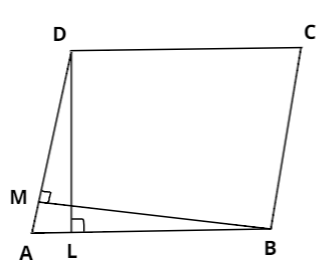
In the given figure, $DL$ and $BM $are heights on sides $AB$ and $AD$ respectively of parallelogram $ABCD$. If the area of the parallelogram is $1470c{m^2},AB = 35cm$ and $AD = 49cm$, find the length of $BM$and $DL$.


Answer
608.4k+ views
Hint: Use formula, Area of parallelogram $ = $base $ \times $ height.
Given, the area of parallelogram is $1470c{m^2}$and $AB = 35cm$ and $AD = 49cm$ are bases of the parallelogram.
$DL$ and $BM$ are the corresponding heights of the parallelogram.
We know that, Area of parallelogram $ = $base $ \times $ height. Using this formula for finding $DL$:
$
\Rightarrow 1470 = AB \times DL, \\
\Rightarrow 1470 = 35 \times DL, \\
\Rightarrow DL = 42. \\
$
Similarly for $BM$:
$
\Rightarrow 1470 = AD \times BM, \\
\Rightarrow 1470 = 49 \times BM, \\
\Rightarrow BM = 30. \\
$
Therefore, the lengths of $DL$ and $BM$ are $42cm$ and $30cm$ respectively.
Note: There is another formula of area of parallelogram as:
Area of parallelogram $ = \frac{1}{2} \times $(product of diagonals).
We can use either formulae wherever required, as per our convenience.
Given, the area of parallelogram is $1470c{m^2}$and $AB = 35cm$ and $AD = 49cm$ are bases of the parallelogram.
$DL$ and $BM$ are the corresponding heights of the parallelogram.
We know that, Area of parallelogram $ = $base $ \times $ height. Using this formula for finding $DL$:
$
\Rightarrow 1470 = AB \times DL, \\
\Rightarrow 1470 = 35 \times DL, \\
\Rightarrow DL = 42. \\
$
Similarly for $BM$:
$
\Rightarrow 1470 = AD \times BM, \\
\Rightarrow 1470 = 49 \times BM, \\
\Rightarrow BM = 30. \\
$
Therefore, the lengths of $DL$ and $BM$ are $42cm$ and $30cm$ respectively.
Note: There is another formula of area of parallelogram as:
Area of parallelogram $ = \frac{1}{2} \times $(product of diagonals).
We can use either formulae wherever required, as per our convenience.
Recently Updated Pages
Master Class 9 Social Science: Engaging Questions & Answers for Success

Master Class 9 Science: Engaging Questions & Answers for Success

Master Class 9 English: Engaging Questions & Answers for Success

Master Class 9 Maths: Engaging Questions & Answers for Success

Master Class 9 General Knowledge: Engaging Questions & Answers for Success

Class 9 Question and Answer - Your Ultimate Solutions Guide

Trending doubts
Which places in India experience sunrise first and class 9 social science CBSE

Fill the blanks with the suitable prepositions 1 The class 9 english CBSE

Write the 6 fundamental rights of India and explain in detail

Difference Between Plant Cell and Animal Cell

What is pollution? How many types of pollution? Define it

What is the Full Form of ISI and RAW




